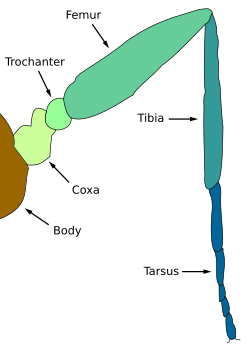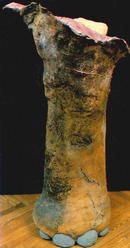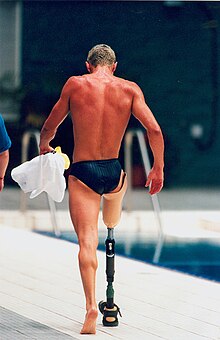Leg
| Leg | |
|---|---|
 Diagram of an insect leg | |
| Details | |
| Identifiers | |
| Latin | membrum inferius |
| TA98 | A01.1.00.031 |
| TA2 | 156 |
| FMA | 24879 |
| Anatomical terminology | |
Alegis aweight-bearingandlocomotiveanatomical structure, usually having acolumnarshape. During locomotion, legs function as "extensible struts".[1]The combination of movements at all joints can be modeled as a single, linear element capable of changing length and rotating about an omnidirectional "hip" joint.
As an anatomicalanimalstructure, it is used forlocomotion.Thedistalend is often modified to distributeforce(such as afoot). Most animals have an even number of legs.
As a component of furniture, it is used for the economy of materials needed to provide the support for the useful surface, such as the table top or chair seat.
Terminology
- Uniped:one leg, such as clams
- Biped:two legs, such as humans and birds
- Triped:three legs, which typically does not occur naturally in healthy animals
- Quadruped:four legs, such as dogs and horses
Manytaxaare characterized by the number of legs:
- Tetrapodshave four legs. Squamates of genusBipeshave only two. Caecilians and many squamate lineages convergently lost their legs.CetaceansandSirenianshave lost their hind legs.
- Panarthropoda:no less than four legs. Velvet worms and some arthropods have more than a dozen legs; a few species possess over one hundred. Despite what their names might suggest,centipedes( "hundred feet" ) may have fewer than twenty or more than 300 legs, andmillipedes( "thousand feet" ) have fewer than 1,000 legs, (exceptEumillipes) but up to 750.
Components
A leg is a structure ofgross anatomy,meaning that it is large enough to be seen unaided. The components depend on the animal. In humans and other mammals, a leg includes thebones,muscles,tendons,ligaments,blood vessels,nerves,andskin.Ininsects,the leg includes most of these things, except that insects have anexoskeletonthat replaces the function of both the bones and the skin.
Sometimes the end of the leg, orfoot,is considered part of the leg; other times it is considered separate. Similarly, thehip jointor other place where the leg attaches to the main body may be considered separate or part of the leg.
Tetrapod legs

Intetrapodanatomy,legis used to refer to the entirelimb.In human medicine, the precise definition refers[2][3][4]only to the segment between thekneeand theankle.This lower segment is also called theshank,[5][6]and the front (anterior) of the segment is called theshinorpretibia.
Inbipedaltetrapods,the two lower limbs are referred to as the "legs" and the two upper limbs as "arms" or "wings" as the case may be. In quadrupedal tetrapods, the limbs are generally called forelegs, fore legs or front legs and hindlegs, hind legs or back legs.
Arthropod leg
Robotic leg
Arobotic legis moved by anactuator,which is a type ofmotorfor moving or controlling a mechanism or system. It is operated by a source of energy, usually in the form of an electric current,hydraulic fluidpressure orpneumaticpressure, and converts that energy into motion.
Prosthetic leg

Aprostheticleg is an artificial leg that is used to replace one that has been lost.
References
- ^"Studies in the Mechanics of the Tetrapod Skeleton".Biologists.org.Archivedfrom the original on 9 July 2008.Retrieved21 September2010.
- ^"Leg".Medical Subject Headings (MeSH).National Library of Medicine.Archivedfrom the original on 22 December 2015.Retrieved18 April2009.
- ^"Leg".Dorland's Medical Dictionary for Healthcare Consumers.Mercksource. Archived fromthe originalon 14 October 2011.Retrieved18 April2009.
- ^"leg".Merriam-Webster Dictionary.Merriam-Webster.
- ^Kardong, Kenneth V. (2009).Vertebrates: Comparative anatomy, function, evolution(5th ed.). McGraw-Hill. p. 340.ISBN978-0-07-304058-5.
- ^"shank".Merriam-Webster Dictionary.Merriam-Webster.
External links
 Media related toLegat Wikimedia Commons
Media related toLegat Wikimedia Commons
